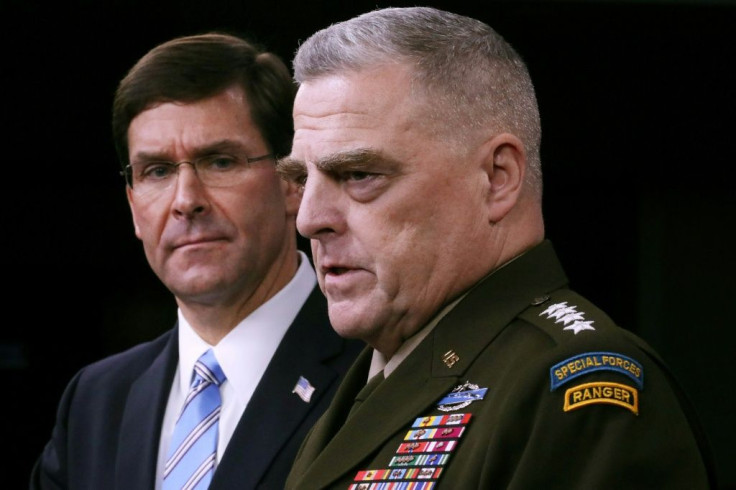More Signs Of Break Between Trump And Military: Gen. Milley Says 'Mistake' To Accompany Trump For Photo Op

KEY POINTS
- Trump late Wednesday threatened to use federal force to rout protesters in Seattle but was told to butt out by both the mayor and governor
- Gen. Mark Milley said he regrets accompanying Trump last week for a photo op, saying he thought they were going to inspect damage to Lafayette Square and talk to National Guard troops
- Milley's comments came one day after Trump shut down Pentagon consideration of whether to rename military installations bearing the names of Confederate leaders
With President Trump promoting the use of the National Guard to quell racial justice protests, military leaders indicated they are uncomfortable with the approach and openly rejected the use of troops for law enforcement duties.
Trump late Wednesday criticized Seattle’s handling of the demonstrations against the death of George Floyd, who died begging for air as a white police officer knelt on his neck, touching off days of sometimes violent protests not only in the United States but around the world.
Trump threatened: “Take back your city NOW. If you don’t do it, I will.”
Trump’s tweets prompted a retort from Seattle Mayor Jenny Durkan, who told the president to “go back to your bunker,” a reference to the decision by the Secret Service to hustle Trump to a safe area as protesters massed outside the White House May 29.
Make us all safe. Go back to your bunker. #BlackLivesMatter https://t.co/H3TXduhlY4
— Jenny Durkan (@MayorJenny) June 11, 2020
Gov. Jay Inslee also responded, calling Trump “incapable of governing.”
A man who is totally incapable of governing should stay out of Washington state’s business. “Stoop” tweeting. https://t.co/O6i04qmZ9v
— Jay Inslee (@JayInslee) June 11, 2020
The Twitter spat began after protesters set up tents in what the demonstrators are calling the “Capitol Hill Autonomous Zone,” blocking streets around the East Precinct police station in the Capitol Hill area, and took place amid an unease among military leaders.
Trump has been demanding National Guard troops be used to put down the protests and offered to send in regular Army troops to handle the situation. Federal police backed by guardsmen used tear gas and rubber bullets to clear Lafayette Park of peaceful protesters June 1 so Trump could walk across the street to St. John’s Church for a photo op. He threatened to invoke the Insurrection Act, which would have given him the power to deploy active-duty troops against protesters.
Joint Chiefs of Staff Chairman Gen. Mark Milley said Thursday he never should have accompanied Trump on that walk in a prerecorded video address to National Defense University graduates.
“I should not have been there,” Milley said. “My presence in that moment and in that environment created a perception of the military involved in domestic politics.”
Milley called Floyd’s death “senseless” and said he is opposed to using the military against protesters.
Watch Gen. Mark Milley, the country’s top military official, apologize for his role in President Trump’s walk across Lafayette Square for a photo op after authorities used tear gas and rubber bullets to clear the area of peaceful protesters.
— The New York Times (@nytimes) June 11, 2020
Read more. https://t.co/5ytpwCd3HF pic.twitter.com/mfDmWh4OMI
Defense Secretary Mark Esper also has expressed regret for taking part, saying he did not know in advance what Trump had in mind, and former Defense Secretary James Mattis, a retired Marine Corps general, last week wrote the Lafayette Square incident was an “abuse of executive authority.” Esper and Milley said they thought Trump was going to inspect damage to Lafayette Square and meet with guardsmen, not pose for pictures holding a Bible aloft.
In a letter to Congress Wednesday, Esper and Milley said the 3,800 guardsmen on hand played a supporting role ionly n last week’s capital protests, and the preparation of 1,700 active-duty troops, including members of the 82nd Airborne Division, for deployment was just precautionary. They said regular troops were “not ever in the District for purposes of civilian law enforcement … [They] did not actively participate in the clearing of Lafayette Park.”
The D.C. National Guard reportedly is investigating exactly what occurred.
Milley's comments came one day after Trump put a stop to Pentagon consideration of taking the names of Confederate leaders off of military installations.
© Copyright IBTimes 2025. All rights reserved.






















